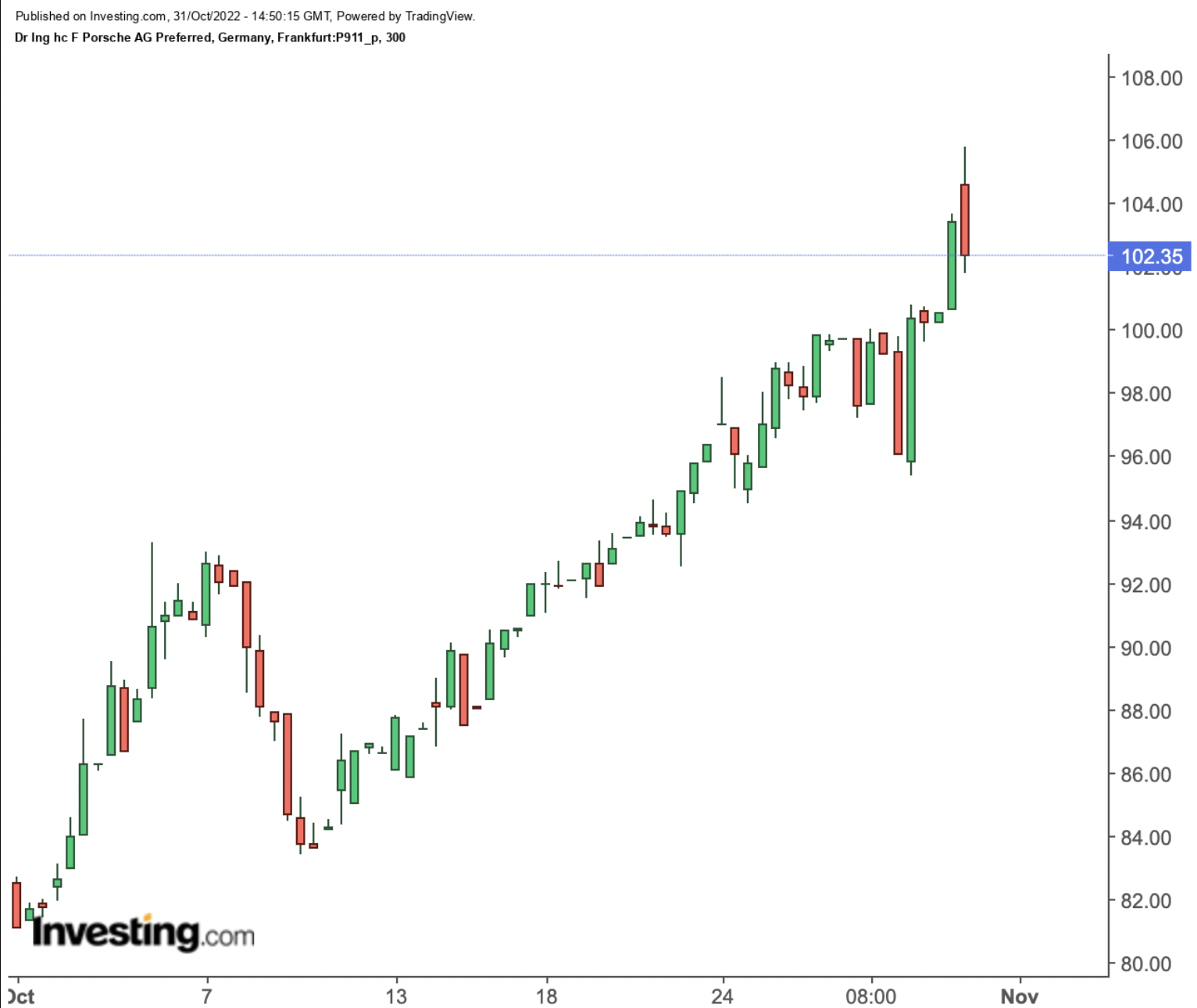- Last month, Porsche executed one of the biggest and most desired initial public offerings in European history
- With macroeconomic headwinds swirling, a current €100-billion valuation looks questionable
- Long-term, this is a wonderful business to own. Investors likely will be able to get it cheaper, however
It would seem as if Porsche AG (F:P911_p) (OTC:POAHY) picked the absolute worst time to execute its initial public offering. Global equity markets are in turmoil, inflation is running rampant, supply-chain issues remain and recession risks loom over key markets. For a cyclical business like auto manufacturing — even luxury auto manufacturing — those external factors usually lead to lower profits and a lower valuation.
So far, however, neither has been the case for Porsche AG P911 stock, which has rallied nicely, gaining 22% from its IPO price of €82.50 in its first month of trading. One key reason for the optimism was a strong third-quarter report that suggests the business remains nicely on track.
That said, both the relatively high IPO price — at the top of the initial range — and the rally since have moved Porsche’s valuation to nosebleed levels. Friday’s close suggests a market capitalization right at €100 billion.
In this environment, that seems potentially too high. Once the novelty of Porsche AG stock wears off, investors may be able to get an attractive long-term story for a much cheaper price.

Source: Investing.com
The Macro Risk
The core of the bear thesis for Porsche stock here is that new auto sales take a big hit in a downturn. That risk does not seem to be priced into F911 stock at the moment.
Again, Porsche AG’s market cap now sits at €100 billion. Based on year-to-date results — including operating profit of €5.05 billion — net income this year should be in the range of €5 billion, for a price-to-earnings multiple around 20x.
On its face, that doesn’t sound all that high. But there’s a risk that external factors upend the company’s recent track record of impressive growth. China has grown to become the company’s largest market by deliveries, accounting for 32% of the 2021 total. Its business activity shrank in October, and there are fears of a “hard landing” in that country after decades of soaring economic growth
A total of 29% of deliveries go to Europe: the challenges on the continent are well-known, ranging from inflation to the Russian invasion of Ukraine. The U.S. accounts for 26%; the weakened euro provides some help to Porsche, but recession fears are rising in that market amid aggressive action from the Federal Reserve.
As a result, 2022 earnings look like they may well be a mid-term peak. Paying 20x earnings at a peak is always dangerous — even for a business as attractive as Porsche.
2022 Challenges
To be fair, there’s an argument that 2022 does not represent peak performance for Porsche. The macro environment already has weakened, and the company is dealing with a number of challenges.
Most notably, like essentially every other auto manufacturer, Porsche’s supply chain remains snarled. Per the IPO prospectus, the company hasn’t been able to fulfill orders for the Taycan EV owing to semiconductor shortages. Wait times between orders and deliveries have ballooned.
Porsche is dealing with inflationary challenges as well, notably in terms of energy at its European facilities. Even assuming the macroeconomic environment does deteriorate, potentially there should be some benefit as supply chains and (hopefully) energy prices normalize.
But Porsche itself doesn’t seem to be suggesting the current environment is all that difficult, at least in terms of costs. The company is guiding for operating profit margins this year of 17% to 18%; the mid-term target is 17% to 19%. Pre-pandemic margins (which can be viewed in annual reports from Volkswagen AG (ETR:VOWG_p) (OTC:VWAGY), Porsche’s majority owner) were in roughly the same range.
Costs absolutely have increased. For now, at least, Porsche has been able to pass along most of those elevated costs to customers.
Again, the risk is that the positive trend will change. No one knows that better than Porsche, which struggled badly during the financial crisis of 2008-09. Debt incurred in a failed effort to take over Volkswagen was a factor, but Porsche was in real trouble. It’s why the company wound up selling 49.9% to Volkswagen for just €3.9 billion That implied a valuation under €8 billion for the entire company. Again, Porsche’s market cap now sits at €100 billion, more than 12x as high.
The Long-Term Case for Porsche AG
All that said, long-term Porsche AG stock still looks attractive — at the right price. The company is leading in electric vehicles: the company is targeting 50% of its deliveries being electric by 2025. Major American manufacturers, in particular, are far behind in that category.
The luxury nature of the brand suggests Porsche should be able to muddle through macro difficulties better than most. Its customers are less likely to be significantly impacted by recessions or (particularly) inflation. Over time, Porsche profits should grow — and in that context, the current valuation is not quite that demanding.
In the meantime, however, risks abound. And it’s important to remember what exactly this IPO was: an offering of a thin slice of a well-known business for the first time. It’s a setup that invites buying — particularly because nearly half of investors reportedly couldn’t get an allocation in the deal — almost immediately.
At some point, however, Porsche will be just another cyclical stock. That is when long-term investors should start paying closer attention.
Disclaimer: As of this writing, Vince Martin has no positions in any securities mentioned.
